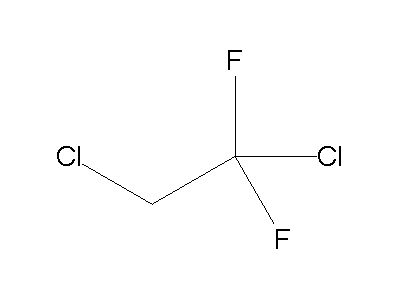Molar mass 66.05 g/mol Density 2.7 g/cm³ | Formula C2H4F2 | |
 | ||
Combustion of gas duster 1 1 difluoroethane c2h4f2
1,1-Difluoroethane, or DFE, is an organofluorine compound with the chemical formula C2H4F2. This colorless gas is used as a refrigerant, where it is often listed as R-152a (refrigerant-152a) or HFC-152a (hydrofluorocarbon-152a). As an alternative to chlorofluorocarbons, it has an ozone depletion potential of zero, a lower global warming potential (120) and a shorter atmospheric lifetime (1.4 years). It has recently been approved for use in automobile applications as an alternative to R-134a.
Contents

Production
1,1-Difluoroethane is produced by the mercury-catalyzed addition of hydrogen fluoride to acetylene:
HCCH + 2 HF → CH3CHF2The intermediate in this process is vinyl fluoride, the monomeric precursor to polyvinyl fluoride.
Uses

In addition to serving as a refrigerant, 1,1-difluoroethane is also commonly used in gas duster (commonly thought of as "canned air") and many consumer aerosol products, especially those subject to stringent VOC requirements.

The molecular weight of difluoroethane is 66, making it useful and convenient tool for detecting vacuum leaks in GC-MS systems.
Safety
The practice of deliberately inhaling or “huffing” canned air can be fatal. It caused a fatal cardiac arrhythmia in a 42-year-old man. Several reports of fatal car crashes have been linked to drivers huffing 1,1-difluoroethane. Because of inhalant abuse, a bitterant is added to consumer canned air products.
In a DuPont study, rats were exposed to up to 25,000 ppm (67,485 mg m−3) for six hours daily, five days a week for two years. This has become the no-observed-adverse-effect level for this substance. Prolonged exposure to 1,1-difluoroethane has been linked in humans to the development of coronary disease and angina.
Though not extremely flammable in gaseous form, 1,1-difluoroethane can burn under some conditions. As such, there is also a warning label present on some gas dusters. When inverted to spray liquid, the boiling fluorocarbon aerosol is easily ignitable, producing a very large blast of flame and extremely toxic gases such as hydrogen fluoride and carbonyl fluoride as combustion products.
